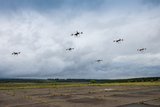US Navy foresees an uncrewed future for its surface and underwater fleet
The service has been conducting various procurement and development efforts to integrate unmanned surface and underwater vehicles into its inventory.
NASA's Global Hawk unmanned aerial vehicle (UAV) is set to begin flights to support improvements in hurricane tracking and forecasting as part of a US National Oceanic and Atmospheric Administration (NOAA) project, NASA announced on 25 August.
The project, known as the Sensing Hazards with Operational Unmanned Technology (SHOUT) mission, will be managed from the ground control station at NASA’s Wallops Flight Facility in Wallops Island, Virginia.
SHOUT builds on previous collaborative research led by NASA, and will will move the Global Hawk closer to being put into operational use as a weather forecast observations tool.
Scientists and pilots will direct a series of flights over the Atlantic Ocean basin from now until the end of September to gather information on direction, wind speed, moisture and temperature. The National Hurricane Center’s National Weather Service forecast models will receive the real time data.
The UAV is equipped with instruments to profile the inner workings of storms. These include dropsondes to profile temperature, pressure, wind speed and direction; high-altitude wind and rain imaging equipment; a high-altitude sounding radiometer; a microwave sounder instrument; and a lightening instrument package.
Through the SHOUT mission, the scientists will test if the data collected by the Global Hawk can act as a replacement to the data collected by the satellites, in the event of a satellite going down.
Gary Wick, lead scientist, SHOUT, NOAA, said: ‘We’re hopeful that won’t occur, but we need to evaluate all options. The Global Hawk allows us to stay over these weather patterns a greater amount of time than manned aircraft. It provides us with an observing tool that has the endurance of a satellite but provides finer resolution data and precision of an aircraft.’
Robbie Hood, director of NOAA’s Unmanned Aircraft System programme, said: ‘We’re flying the Global Hawk above hurricanes and other severe storms to refine it as a new, powerful tool to better forecast where hurricanes go and how intense they are. The mission is part of NOAA’s work to improve our nation’s preparedness and resilience to hurricanes and other severe storms.’

The service has been conducting various procurement and development efforts to integrate unmanned surface and underwater vehicles into its inventory.

Tekever has manufactured the AR3, AR4 and AR5 UAS with all systems sharing common electronics and software architecture, which has enabled the reuse of ground segment elements within the new ARX UAS.

As the dynamics of aerial combat rapidly evolve, Chinese scientists have engineered a sophisticated air separation drone model that can fragment into up to six drones, each capable of executing distinct battlefield roles and challenging the efficacy of current anti-drone defences such as the UK’s Dragonfire laser system.

Advancements in air defence technologies have begun to reshape aerial combat dynamics in the Middle East, as illustrated by recent events involving the Israeli Air Force and Hezbollah.

Both sides of the Russia-Ukraine war have been using UAS for effective low-cost attacks, as well as impactful web and social media footage. Thousands more have now been committed to Ukrainian forces.

The US Army has intentions to develop light, medium and heavy variants of the Robotic Combat Vehicle (RCV) as part of the branche’s Next Generation Combat Vehicle family.